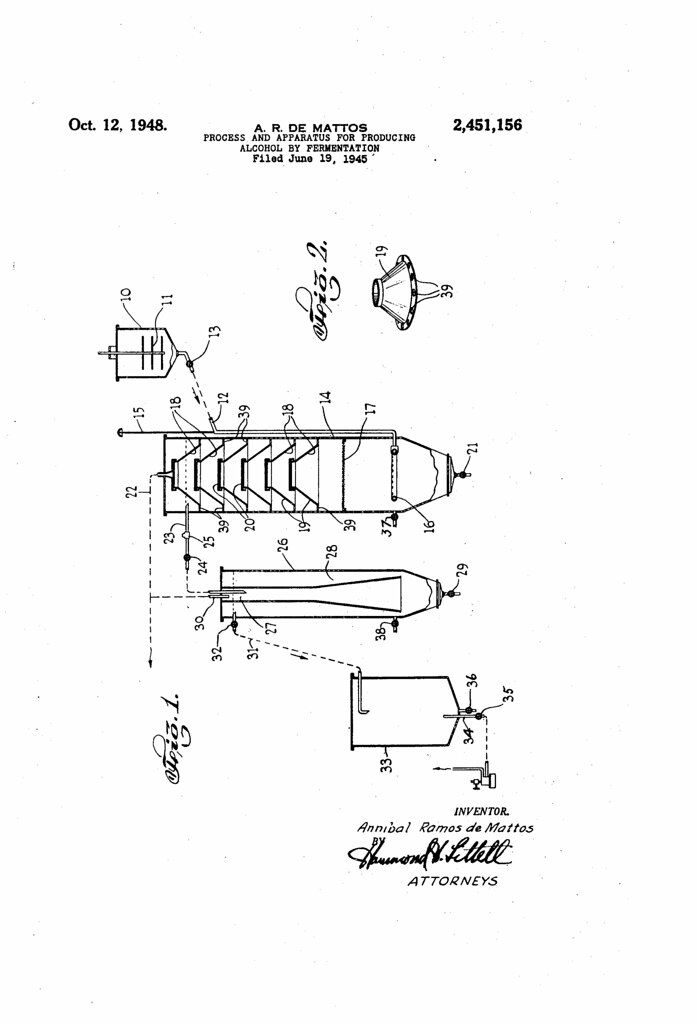
Today in 1984, US Patent 2451156 A was issued, an invention of Annibal Ramos De Mattos, for his “Process and Apparatus for Producing Alcohol by Fermentation.” There’s no Abstract, although in the description it includes these claims:
This invention relates to a process and apparatus for yeast fermentation and, more particularly, for producing alcohol by fermentation.
Commercially, alcohol is customarily produced by a batch or a modified batch process. In such processes the yeast necessary to convert the nutrient medium or wort into alcohol must be grown on the wort or on an outside nutrient medium. Yet as the conversion of the wort to alcohol takes place and the concentration of alcohol increases, the medium becomes toxic to the yeast. As a result, the alcohol ultimately present in high concentration kills a certain portion of the yeast, and the wort consumed in the production of this yeast is lost. Additionally, in such processes the concentration of yeast and its contact with the nutrient medium is seldom best adapted for optimum rate of alcohol conversion.
In the production of alcohol by conventional fermentation processes, it is usually necessary to kill or prevent the growth of bacteria which are deleterious to the propagation of the yeast or impede the conversion of the nutrient medium to alcohol. These deleterious bacteria are controlled either by subjecting the wort to heating at sterilization temperatures or by the introduction of chemical bactericides such as sulfuric acid, hydrochloric acid, fluorides, copper sulfate, and the like. It is also known that nutrients suitable for conversion to alcohol by fermentation, particularly cheaper nutrients such as low grade sugar, seldom contain all the elements necessary for the nutrition and propagation of the yeast which convert the nutrient into alcohol. As a result, the conventional nutrient medium must be complemented by the addition of so called stimulants such as the various mineral salts including, for instance, sulfates and nitrates of ammonia, calcium super-phosphates, and the like, or organic substances such as urea, malt, peptone, and the like.
The known commercial processes of producing alcohol by yeast fermentation may be divided roughly into four types; namely, progressive filling, division, continuous feeding, and a fourth process in which the yeast is recovered and reused in subsequent fermentation vats.
In the first-mentioned process a group of vats is placed in series and fermentation initiated in one of the vats. When the fermentation has reached a desired point, a portion of the fermenting wort in the first vat is transferred to a second vat to initiate the fermentation therein and so on for any desired number of vats.
In the second-mentioned process the contents of one vat is used for the purpose of inoculating other vats. For instance, after a group of vats has been used for fermenting wort to alcohol, one of the group is not discharged but is retained for the purpose of distribution to the vats which have been discharged for the purpose of initiating the fermentation of fresh wort.
The third-mentioned continuous feeding process is a very old process introduced by Guillaume, involving inoculating a multiplicity of fermentation vats from a culturing vat.
The fourth process is of more recent origin and was patented by Melle and Bolnot. In this last-mentioned process the pH of the fermenting wort is carefully controlled to approximate a pH of 3. When the fermentation is nearly complete, the partially spent wort and yeast are passed into a centrifuge where the yeast is recovered in the form of a liquid containing a high concentration of yeast. This liquid is used for the purpose of initiating the fermentation of a new charge of wort. This latter process has a number of disadvantages involving, as it does, the necessity for controlling pH of the fermentation mass and requiring the addition of conventional stimulants and the like used in other fermentation processes. The centrifuging device involves added equipment costs. The process makes possible some saving in fermentation equipment but not nearly so much as is possible in accordance with my continuous process described in detail hereinafter.

